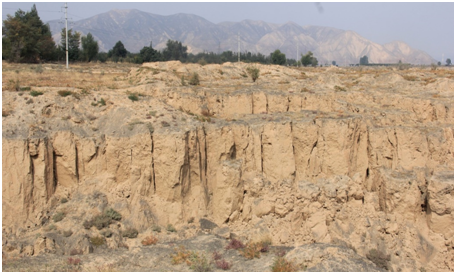The ubiquitous existence of Loess vertical joints (LVJs) plays an essential role in the geomorphologic evolution of loess regions (e.g., platforms, ridges, and domes), the occurrence of geohazards (e.g., landslides, mudflows, and soil erosion), and synergies between human activities and geological environment effects in the loess-landscape system.
Recently, a team led by Prof. JIN Zhao from the Institute of Earth Environment (IEE) of the Chinese Academy of Sciences conducted extensive field investigation and experiments to enhance the understanding of morphologies, cross-scale transformation mechanism, and structural bases of LVJs, revealing the development and evolution processes of LVJs from the perspective of considering loess sedimentary dynamics.
The results showed that the pore concentration zones at the microscale and the vertical tubular channels at the mesoscale in loess were the structural bases of the formation of original vertical joints, which facilitated the loess anisotropy and LVJs evolution. Original vertical joints were the product of diagenesis in loess strata during loess historical sedimentary process.
They also found that the morphologies of LVJs varied with the microtopography at different spatiotemporal scales, and was characterized by the cross-scale transformation mechanism, i.e., that they could transform up (i.e., an expansion behavior) or down (i.e., a degradation behavior) at the micro-, meso-, and sub-macro scales under the influences of dry-wet cycles, loess pile thickening, and exogenic forces.
Moreover, researchers suggested that the distribution variability of LVJs mainly depended on the differences in structural characteristics of loess, water driving forces (e.g., rainfall or irrigation), loess strata (e.g., sedimentary depth), and microtopography, as well as weathering.
These findings not only lay the solid foundation for further issues on the origin, development and evolution of original vertical joints in loess, but also substantially contribute to understanding the anisotropic genesis of loess, structural evolution, preferential flow, and the occurrence of geohazards such as landslides and soil erosion.
This work, published in Engineering Geology, was supported by the National Key R&D Program of China (2018YFC1504700) and the National Natural Science Foundation of China (41790444 and 41530640).

Fig.1 Typical development characteristics of loess vertical joints (LVJs) on the edge of the Heifangtai tableland, Gansu Province, China (Imaged by Jin, et al.)
Contact: Bai Jie, Institute of Earth Environment, Chinese Academy of Sciences, Xi'an, China. Email: baijie@ieecas.cn
 © 2015 Institute of Earth Environment,CAS
© 2015 Institute of Earth Environment,CAS Address:No. 97 Yanxiang Road, Xi'an 710061, Shaanxi, China

 Location :
Location :